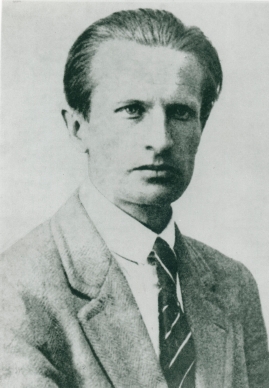Viking Eggeling
Table of contents
- Basic facts
- Links and resources
- Biography
- Awards
- Films
- Original work
- Soundtrack listing
- Groups
Basic facts
Media (1)
| Director |
|
|---|
Biography
Swedish pictorial artist and director. Born in Lund, Sweden. Died in Berlin, Germany.-Viking Eggeling is one of the foremost names in the movement of experimental filmmakers who enriched European cinema in the 1920s. One of the central works of the international avant-garde, his only finished film, Symphonie diagonale (1924), was a major influence on the development of the formal language of nonfigurative cinema.Following his childhood in the university town of Lund, Eggeling left Sweden as a teenager to study economics, but soon decided to...
Biography
Swedish pictorial artist and director. Born in Lund, Sweden. Died in Berlin, Germany.
-
Viking Eggeling is one of the foremost names in the movement of experimental filmmakers who enriched European cinema in the 1920s. One of the central works of the international avant-garde, his only finished film, Symphonie diagonale (1924), was a major influence on the development of the formal language of nonfigurative cinema.
Following his childhood in the university town of Lund, Eggeling left Sweden as a teenager to study economics, but soon decided to try his luck as a painter. Travelling around Europe, he first paid his way by working as a bookkeeper, then as a teacher of drawing. He made his own studies of art history and drawing. Around 1911 he moved to Paris to live as an artist and soon came into contact with many of the leading names on the Paris art scene. Subsequently he moved to Zürich, where he was a contributor to Dadaist exhibitions. He began to draw abstract patterns on scrolls, and spent some considerable time on the two projects "Horisontell-vertikal orkester" and "Diagonalsymfoni," in which he attempted to create a universal pictorial language, inspired both by his peers and by the French philosopher Henri Bergson (1859-1941).
His meeting with the like-minded German filmmaker and artists Hans Richter had a decisive impact on Eggeling's view of film as an art form. Together in Berlin they experimented with animated films and attempted to make a full film version of "Horisontell-vertikal orkester", a task which was never completed. Eggeling ended his partnership with Richter, but continued to work together with Bauhaus student Erna Niemeyer (1901-1996) on a film based on "Diagonalsymfoni." It was made using a simple animation technique in which forms cut out of tinfoil were the principal element. The various forms were masked off and rearranged, and by using double exposure, Eggeling could control the movements of the abstract forms. Under the French title Symphonie diagonale, the completed film was first screened in Berlin in November 1924, and had its public premiere at the Ufa Palast on 3 May 1925. Yet by that time Eggeling was already dangerously ill, and he died on 19 May of the same year.
Viking Eggeling's Symphonie diagonale quickly established its place in international experimental film. But he received no real recognition in Sweden until 1958, when Moderna Museet in Stockholm organised a film festival in his honour. In the wake of this, Eggeling's work assumed a strong symbolic meaning for a new generation of experimental filmmakers. One problem surrounding his film is the lack of clarity as to how it was actually edited. A number of versions have been circulated, and researchers have attempted to reconstruct the film from various starting points. One idea, promoted by Gösta Werner and the music expert Bengt Edlund, is that the structure of the film is based on musical principles. The academic and art film director Malcolm Le Grice has pointed out the close similarities between Eggeling's abstract formal language and digital art.
A source of further reference for Viking Eggeling is Louise O'Konors book "Viking Eggeling, 1880-1925, Artist and Filmmaker, Life and Work (Stockholm 1971).
Lars Gustaf Andersson (2012)
(translated by Derek Jones)
Films
| Director |
|
|---|

